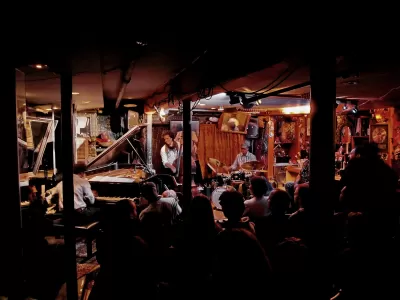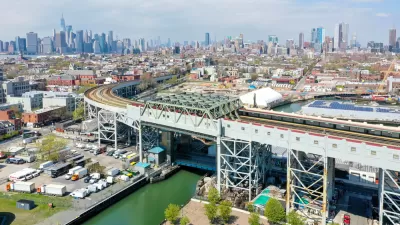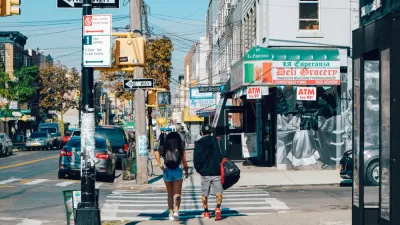A study of the musical nightlife of New York shows these spaces are an integral part of the city’s urban landscape.

A report released in September called Creative Footprint NYC takes a closer look at music venues in the city, their role in fostering community, and ways to ensure that they do not disappear.
In addition to locating the venues, the study considered the type of music the venues made available, reports Feargus O’Sullivan:
Crucially, the report doesn’t only measure venue size and location; it also develops metrics that help to assess the cultural and community value of each site. It does this by creating an “experimental output” metric that appraises the extent to which a venue provides non-mainstream alternatives to commercial offerings, and thus to what extent it broadens the city’s cultural possibilities.
Most venues are in Manhattan, but the bulk of experimental venues are in Brooklyn and Queens, according to the report. Gentrification and rising rents in these areas can threaten these alternative venues, and the consequences can run deep, O’Sullivan points out:
And when less commercial venues are forced to close, a focal point for part of the local community is lost, as is a place where some social divides are bridged. When these venues are cultural beacons for minority communities, which themselves face the threat of displacement, the potential damage to community cohesion and neighborhood identity is even greater.
Part of remedying this, says Sullivan, is understanding the value and contribution of these music venues. In addition, policies can support music venues, such as developer incentives, rent control, and easier permitting processes. “Something needs to be done to protect and nurture the city’s vitality, to prevent it from becoming a mere dormitory for the better off. That something could—indeed should—involve a more positive attitude to nightlife,” argues Sullivan.
FULL STORY: What Small, Diverse Music Venues Mean to New York City

Alabama: Trump Terminates Settlements for Black Communities Harmed By Raw Sewage
Trump deemed the landmark civil rights agreement “illegal DEI and environmental justice policy.”

Planetizen Federal Action Tracker
A weekly monitor of how Trump’s orders and actions are impacting planners and planning in America.

The 120 Year Old Tiny Home Villages That Sheltered San Francisco’s Earthquake Refugees
More than a century ago, San Francisco mobilized to house thousands of residents displaced by the 1906 earthquake. Could their strategy offer a model for the present?

In Both Crashes and Crime, Public Transportation is Far Safer than Driving
Contrary to popular assumptions, public transportation has far lower crash and crime rates than automobile travel. For safer communities, improve and encourage transit travel.

Report: Zoning Reforms Should Complement Nashville’s Ambitious Transit Plan
Without reform, restrictive zoning codes will limit the impact of the city’s planned transit expansion and could exclude some of the residents who depend on transit the most.

Judge Orders Release of Frozen IRA, IIJA Funding
The decision is a victory for environmental groups who charged that freezing funds for critical infrastructure and disaster response programs caused “real and irreparable harm” to communities.
Urban Design for Planners 1: Software Tools
This six-course series explores essential urban design concepts using open source software and equips planners with the tools they need to participate fully in the urban design process.
Planning for Universal Design
Learn the tools for implementing Universal Design in planning regulations.
Jessamine County Fiscal Court
Caltrans
Institute for Housing and Urban Development Studies (IHS)
City of Grandview
Harvard GSD Executive Education
Toledo-Lucas County Plan Commissions
Salt Lake City
NYU Wagner Graduate School of Public Service





























